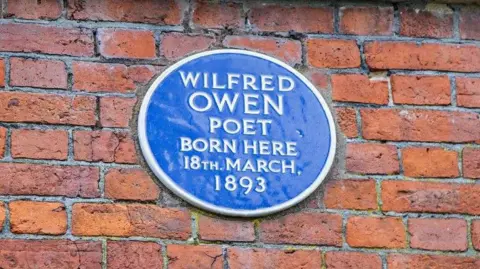 Savills
SavillsThe birthplace of war poet Wilfred Owen has gone on the market.
Born in 1893 in Oswestry, Shropshire, Owen enlisted in the Army in 1915 and witnessed the trench warfare of World War One firsthand.
Injured in 1917, he was sent home, but returned to France in 1918 as a company commander, only to be killed a week before Armistice Day.
Biographers have recorded how, after his death at the age of 25, he came to represent a generation of young men who lost their lives in the conflict.
The Poetry Foundation describes how just five of Owen’s poems were published in his lifetime, and others appeared posthumously, many of them contained in a collection edited by fellow war poet Siegfried Sassoon.
His work recorded the horrors of flooded trenches, poison gas, machine gun fire and intense shelling. Two of his most well-known poems were Dulce et Decorum Est and Anthem for Doomed Youth.
Owen was born at villa Plas Wilmot, and was the son of Thomas Owen, a railway clerk and former seaman, and Susan Owen, the daughter of former Oswestry mayor Edward Shaw.
He had three siblings and the family later moved to Shrewsbury, where he attended school.
 Getty Images
Getty ImagesPeter Daborn, from Savills, which is marketing the home, described it as a “special property which is steeped in history”.
Commenting amid the Remembrance period, he said: “It is a particularly poignant time to launch such an historic property to the market.”
Original features retained in the Grade II listed Georgian property, which has a blue plaque, include sash windows, a ceiling rose, cornicing and parquet floors.
Remembrance events are being held across the West Midlands on Sunday.
Services are being hosted by the cathedrals in Birmingham and Worcester, parades are to be held in Coventry, Sandwell and Wolverhampton, and remembrance events are being held at the Royal Airforce Museum in Cosford, Shropshire, and at the National Memorial Arboretum in Staffordshire.
 Savills
Savills